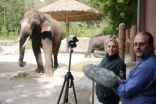(Press-News.org) An Asian elephant named Koshik can imitate human speech, speaking words in Korean that can be readily understood by those who know the language. The elephant accomplishes this in a most unusual way: he vocalizes with his trunk in his mouth.
The elephant's vocabulary consists of exactly five words, researchers report on November 1 in Current Biology, a Cell Press publication. Those include "annyong" ("hello"), "anja" ("sit down"), "aniya" ("no"), "nuo" ("lie down"), and "choah" ("good"). Ultimately, Koshik's language skills may provide important insights into the biology and evolution of complex vocal learning, an ability that is critical for human speech and music, the researchers say.
"Human speech basically has two important aspects, pitch and timbre," says Angela Stoeger of the University of Vienna. "Intriguingly, the elephant Koshik is capable of matching both pitch and timbre patterns: he accurately imitates human formants as well as the voice pitch of his trainers. This is remarkable considering the huge size, the long vocal tract, and other anatomical differences between an elephant and a human."
VIDEO:
This video shows Koshik, "an elephant that speaks Korean, " interacting with his trainer.
Following vocal interaction with the trainer is documented:
Koshik: "choah " (good)
Trainer: "choah choah annyong " (good good hello)
Koshik: "choah "...
Click here for more information.
For one thing, Stoeger says, elephants have a trunk instead of lips. While their large larynx can produce very low-pitched sounds, Koshik's speech mimicry exactly copies the pitch and other characteristics of his human trainers' voices. A structural analysis of Koshik's speech showed not just clear similarities to human voices, but also clear differences from the usual calls of elephants.
There have been some earlier reports of vocal mimicry in both African and Asian elephants. African elephants have been known to imitate the sound of truck engines, and a male Asian elephant living in a zoo in Kazakhstan was said to produce utterances in both Russian and Kazakh, but that case was never scientifically investigated.
In the case of Koshik, Angela Stoeger, Daniel Mietchen, Tecumseh Fitch, and their colleagues confirmed that Koshik was imitating Korean words in several ways. First, they asked native Korean speakers to write down what they heard when listening to playbacks of the elephant's sounds.
"We found a high agreement concerning the overall meaning, and even the Korean spelling of Koshik's imitations," Stoeger says. But as far as the scientists can tell, Koshik doesn't actually mean what he says.
AUDIO:
This is a recording of Koshik imitating human speech:
Trainer (first) and Koshik (second) producing "annyong "(hello)
Click here for more information.
It's not completely clear why Koshik adopted his unusual vocal behavior, but the researchers suggest that it might go back to his days as a juvenile. Koshik was the only elephant living at the Everland Zoo in South Korea for about five years, during an important period for elephant bonding and development. Humans were his only social contacts.
"We suggest that Koshik started to adapt his vocalizations to his human companions to strengthen social affiliation, something that is also seen in other vocal-learning species—and in very special cases, also across species," Stoeger says.
INFORMATION:
Stoeger et al.: "An Asian elephant imitates human speech."
An elephant that speaks Korean
2012-11-01
ELSE PRESS RELEASES FROM THIS DATE:
JCI early table of contents for Nov. 1, 2012
2012-11-01
Congenital diarrheal disorder linked to a mutation in DGAT1
Congenital diarrheal disorders (CDD) are a group of rare intestinal diseases that are caused by genetic mutations. In a study published in the Journal of Clinical Investigation, Robert Farese and colleagues at the University of California, San Francisco, identified a family with two of three children affected by CDD. The affected children both carried a rare mutation in the DGAT1 gene. DGAT1 mediates the formation of triglycerides and is being assessed as a therapeutic target in the treatment of obesity. The study ...
Congenital diarrheal disorder linked to a mutation in DGAT1
2012-11-01
Congenital diarrheal disorders (CDD) are a group of rare intestinal diseases that are caused by genetic mutations. In a study published in the Journal of Clinical Investigation, Robert Farese and colleagues at the University of California, San Francisco, identified a family with two of three children affected by CDD. The affected children both carried a rare mutation in the DGAT1 gene. DGAT1 mediates the formation of triglycerides and is being assessed as a therapeutic target in the treatment of obesity. The study by Farese's group suggests that targeting of DGAT1 could ...
Feedback loop maintains basal cell population
2012-11-01
HOUSTON - (Nov. 2, 2012) – Notch – the protein that can help determine cell fate – maintains a stable population of basal cells in the prostate through a positive feedback loop system with another key protein – TGF beta (transforming growth factor beta), said Baylor College of Medicine researchers in the journal Cell Stem Cell.
"When basal cell homeostasis (or maintenance of a stable population) is disrupted, it may be part of the process that initiates prostate cancer," said Dr. Li Xin, assistant professor of molecular and cellular biology at BCM and a senior author ...
Rice team boosts silicon-based batteries
2012-11-01
HOUSTON – (Nov. 1, 2012) – Researchers at Rice University have refined silicon-based lithium-ion technology by literally crushing their previous work to make a high-capacity, long-lived and low-cost anode material with serious commercial potential for rechargeable lithium batteries.
The team led by Rice engineer Sibani Lisa Biswal and research scientist Madhuri Thakur reported in Nature's open access journal Scientific Reports on the creation of a silicon-based anode, the negative electrode of a battery, that easily achieves 600 charge-discharge cycles at 1,000 milliamp ...
Stem cells show promise for treating infertility in cancer patients
2012-11-01
AUDIO:
This is an audio clip of Deborah Sweet of Cell Stem Cell interviewing Dr. Kyle Orwig of the University of Pittsburgh School of Medicine regarding his recent preclinical study "Spermatogonial...
Click here for more information.
A promising stem-cell-based approach for treating infertility has been successfully demonstrated in non-human primates, as reported in a study published by Cell Press in the November issue of the journal Cell Stem Cell. The preclinical study ...
Meth vaccine shows promising results in early tests
2012-11-01
LA JOLLA, CA – Scientists at The Scripps Research Institute (TSRI) have performed successful tests of an experimental methamphetamine vaccine on rats. Vaccinated animals that received the drug were largely protected from typical signs of meth intoxication. If the vaccine proves effective in humans too, it could become the first specific treatment for meth addiction, which is estimated to affect 25 million people worldwide.
"This is an early-stage study, but its results are comparable to those for other drug vaccines that have then gone to clinical trials," said Michael ...
Predicting what topics will trend on Twitter
2012-11-01
CAMBRIDGE, Mass. -- Twitter's home page features a regularly updated list of topics that are "trending," meaning that tweets about them have suddenly exploded in volume. A position on the list is highly coveted as a source of free publicity, but the selection of topics is automatic, based on a proprietary algorithm that factors in both the number of tweets and recent increases in that number.
At the Interdisciplinary Workshop on Information and Decision in Social Networks at MIT in November, Associate Professor Devavrat Shah and his student, Stanislav Nikolov, will present ...
Plants recognise pathogenic and beneficial microorganisms
2012-11-01
Plant roots are surrounded by thousands of bacteria and fungi living in the soil and on the root surface. To survive in this diverse environment, plants employ sophisticated detection systems to distinguish pathogenic microorganisms from beneficial microorganisms.
Here the so-called chitin molecules from microorganisms, along with modified versions, play an important role as they are detected by the plant surveillance system. Legumes, for example, build a defence against pathogenic microorganisms in response to simple chitin molecules.
However, when the plant detects ...
Great differences between EU Member States in how well transport systems cope with weather phenomena
2012-11-01
This is the first study in the world to evaluate the risks posed to transport by weather phenomena on a country-specific and mode-specific basis. Among the EU Member States, Poland has the highest risk level indicator. The highest-risk regions are in the countries of Eastern Europe and in mountainous areas. Low-risk countries include Ireland, Austria, Luxembourg and the Nordic countries.
The risk-level evaluation was conducted using a risk indicator designed by VTT scientists. The calculations were performed on substantial datasets and involved estimating the ...
Gen X overtaking baby boomers on obesity
2012-11-01
New research from the University of Adelaide shows that Australia's Generation X is already on the path to becoming more obese than their baby boomer predecessors.
Studies show that boomers currently have the highest level of obesity of any age group in Australia. However, new research by University of Adelaide PhD student Rhiannon Pilkington has revealed some alarming statistics. As part of her research, she has compared obesity levels between the two generations at equivalent ages.
Using data from the National Health Survey, Ms Pilkington compared Generation X in ...


